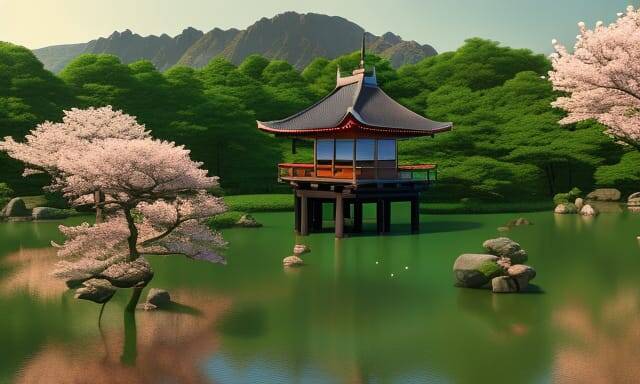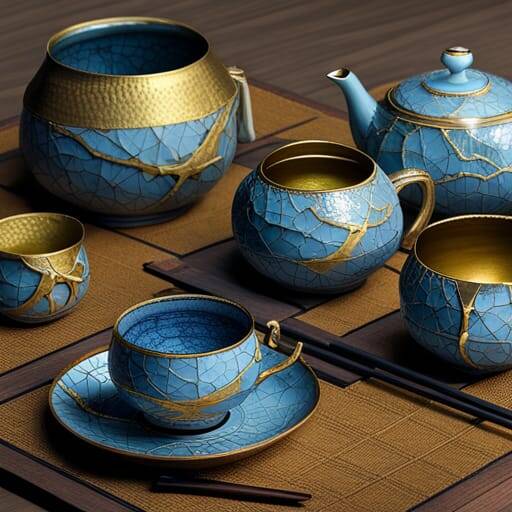Japanese artforms
I already had a long-running fascination with Japanese art forms such as bonsai and Japanese gardens, but generative AI has led me to delve into the more graphic art forms as well. Due to the isolated location of the Japanese islands and the resulting unique culture, Japanese art has its own signature. While influences from China played an important role in the earlier centuries - and even influences from India via Buddhism - Western influences can also be recognized in Japanese art in recent centuries. On the other hand, Western art has also been influenced by Japanese art on several occasions in recent centuries. A good reason to see what generative AI can do with it.
The spectrum of typical Japanese art media in its full breadth ranges from ceramics and sculpture, via sumi-e, calligraphy, ukiyo-e and origami, to bonsai, ikebana and manga. (I'm probably forgetting some media here.) Let's try to give something of an overview below. Following on from last week's topic, we're starting green.
Japanese gardens
There are many types of Japanese gardens and I have not yet managed to make clear to the AI how to generate the different styles. What a layman would expect in any case: moss, stones, a pond and/or replacement gravel, and trees. A tea house or a pagoda make it recognizable even faster. Or Japanese cherry blossom.
The AI has no understanding of the relationship between the various elements and throws them all together more or less randomly on a picture. For example, this tea house does not seem to be really accessible.
Bonsai
The famous miniature trees that look like adult ones also come in many shapes and sizes. Some specimens fit in a teacup (shohin), others are grown to become two meters high garden trees (niwaki). It is the pruning that keeps the tree in its small shape while still looking more and more mature. The growth can be controlled by placing the branches in the desired position with metal wire. The roots are limited in their growth by growing the tree in a pot and - only if really necessary - pruning the roots. All in all, shaping a bonsai requires a lot of patience and dedication. There is no tree species that cannot be manipulated in this way, but small-leaved species and species that do not grow too exuberant make it easier. The most iconic example is undoubtedly a 'Literati' style Japanese pine.
Ikebana
Ikebana is another word for 'flower arranging', but it is the different style that stands out the most. Where in the west the flowers must be abundant and colorful to make an impression, the Japanese prefer a limited number of flowers, preferably an odd number, and also arranged asymmetrically. The relationship between plant and empty space is an important concept in all Japanese art. For the real connoisseurs, the symbolism of the flowers and leaves used is also of great importance.
Ceramics
When we think of Japanese ceramics, we often think of the tea set and the saké cup. These have an understated, simple beauty that embraces imperfection and transience (wabi-sabi), and have had a great influence on Japanese art and culture. Here too, many different styles are possible with unglazed crockery, cups with bumpy edges as if they were not finished, different colors of clay and glaze per region. In addition, the kintsugi technique deserves special attention: repairing broken crockery with gold.
Sculpting
Sculpting in Japan has long been primarily a practical matter - possibly because rocks are highly valued in their natural form. Traditionally, there are some types of stone statues: stone (miniature) pagodas with an odd number of roofs on top of each other; ishi-dōrō or stone lanterns for use in temples and Japanese gardens; and Buddha and monk figurines in memory of deceased monks.
I have not been able to let Stable Diffusion's AI generate an authentic Japanese lantern yet, but I'll keep trying. The example on the right is getting close.
Kalligrafie
Calligraphy is an ancient art in Japan, once imported from China. It is still practiced today with brush and India ink. Unfortunately I can't read Japanese, Chinese, Korean and similar characters, so I can't check if Stable Diffusion actually writes readable characters here. From experience with Western writing, I know that the AI have a lot of trouble with that. For Western writing, I let the AI generate four 'texts' each time, I choose the best of them, and use that as a basis to generate a better version. So this doesn't work if I can't judge for myself whether the characters look good.
With my limited knowledge, the characters on the right look like a parody of the real thing.
Sumi-e
Sumi-e is the Japanese word for ink painting, which involves painting with a brush and ink wash; India ink is then applied to washi paper or silk in various water dilutions. The technique is therefore an extension of calligraphy. Where at first only black and shades of gray were painted, in later centuries colored ink was also used, which greatly increased the possibilities of expression.
Here, too, the difference with Western culture is apparent: with sumi-e, the artist places as few lines and color tones as possible on paper; just enough to create shape, texture and effect. In addition, the meditative aspect also plays a role during painting, whereby the painter is expected to become one with the brush and the ink. Having Sumi-e drawings generated by AI therefore ignores the experience of painting itself.
Within sumi-e, some traditional styles and themes can be identified: the landscape with a flowing river between the mountains, bamboo paintings, and bird and flower paintings. In modern times, both these traditional genres are practiced, as well as more free forms.
Ukiyo-e
Ukiyo-e are Japanese woodblock prints, which have also become popular in Europe since the mid-18th century. For example, everyone has seen a print of The Great Wave off Kanagawa by Katsushika Hokusai. The different colors in a print were printed with different woodcuts that had to connect seamlessly: an impressive piece of artistry.
For the AI, the task is a lot simpler: the Japanese style must be adopted, and the drawing must be colored within the lines. To stay in the style of the 18th century - the original prints of which are almost all discolored by the sun - the use of faded colors seems most genuine.
Origami
It may sound a bit strange, but even origami - the Japanese art of paper folding - can be represented by an AI. The paper looks 'lifelike', but the question is whether a single sheet of paper can be folded as shown by the AI. The classic example is the crane bird, but here an attempt has been made to have a little witch folded in origami style. The feet are clearly not made of the same piece of paper.
Manga
Manga is the Japanese style of comic drawing. An animated manga is called an anime. Japanese text is normally read from top to bottom, then left to right. As a kind of fusion of the Western comic with the Japanese ukiyo-e style, mangas are read from right to left, then from top to bottom. Unlike in the West, comics and cartoons are not mainly made for children, but there is a wide range of stories with a philosophical, mythological or psychological approach.
Yet the characters are often depicted with wide eyes; and both head and eyes are depicted larger when the intended audience is younger.
Conclusion
It was sometimes difficult to display a Japanese art form with the older versions of Stable Diffusion, but with the advance of version 2.1 and SDXL, the reproductions are becoming increasingly faithful. That gives the user of AI the opportunity to dive into all these media and learn more about them while generating them - and enjoy them more.
I just might zoom in on one of the art forms mentioned here in a subsequent blog.












Reactie plaatsen
Reacties